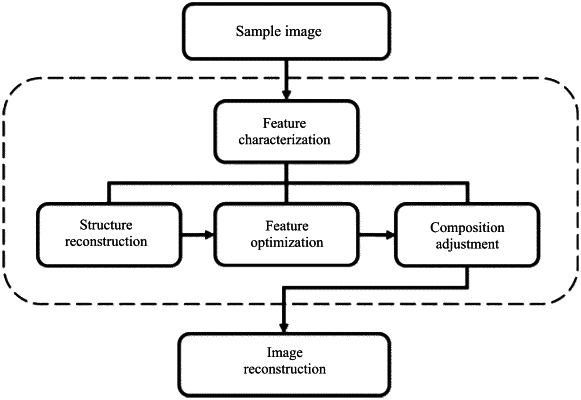| CPC G06T 3/40 (2013.01) [G06T 7/136 (2017.01); G06T 2207/10056 (2013.01); G06T 2207/20016 (2013.01); G06T 2207/30108 (2013.01)] | 1 Claim |

|
1. A high-throughput microstructure characterization and reconstruction method of heterogeneous materials, comprising four parts of feature characterization, structure reconstruction, feature optimization and composition adjustment of a microscopic image, and using the following steps of:
1) Observing a microscopic image of a sample
performing microstructure morphology imaging on a cross-section of the sample by using microscopic observation technique to obtain an original microscopic image Is of the sample;
2) extracting microstructure features of each constituent phase
thresholding processing the original microscopic image Is to separate it into binary images of a matrix phase and each constituent phase, wherein A represents a constituent phase with a size not larger than 10 microns in the original microscopic image Is, B represents a constituent phase with a size not less than 100 microns in the original microscopic image Is, Ak represents the kth constituent phase with a size not greater than 10 microns, and Bj represents the jth constituent phase with a size not less than 100 microns;
for the binary image of each constituent phase A, extracting five physical descriptors of the nearest neighbor distance d, number N, area S, aspect ratio α and volume fraction VF of all particles;
 wherein, qi represents an area of a pixel region occupied by the ith particle in the kth constituent phase, and ai and bi represent lengths of short axis and long axis of the ith particle in the kth constituent phase, respectively;
 wherein, M×H is an area of the original microscopic image Is;
3) constructing a base image of the constituent phase B
a) constructing a multi-resolution pyramid of the constituent phase Bj
constructing an L-layer multi-resolution pyramid of the binary images of the matrix phase and the constituent phase B1 to obtain a sample pyramid image Xjl (l=1, 2, . . . , L) with a resolution from high to low, and constructing an L-layer pyramid Yjl (l=1, 2, . . . , L) of Bj′ to-be-generated;
b) constructing a set of neighborhood pixels of the constituent phase Bj
for each pixel point t to-be-output, taking t point as a center, and expressing a neighborhood with a size of (2ω+1) as:
Nt={s:∥t−s∥∞≤ω,s≠t} (4)
wherein, s represents the pixel points around the central pixel point t, and ω represents a size of the neighborhood;
searching pixel by pixel according to raster scanning order, and learning the neighborhood distribution in XL−hj (h=1, 2 . . . , L−1) and Yjl (l=1, 2 . . . L), an entire neighborhood set NP at this time comprising neighborhood pixels of the current layer XjL−k and neighborhood pixels of the synthesized previous layer YjL;
c) reconstructing the constituent phase Bj according to texture synthesis
according to the multi-resolution pyramid and the neighborhood pixels set in steps a) and b), gradually synthesizing a microscopic image YjL equivalent to XjL from the lowest resolution level, and obtaining a final reconstructed image Yjl by stacking resolution images layer-by-layer to the highest resolution layer, that is, the reconstructed result Bj′ of constituent phase Bj;
d) adjusting the composition of the constituent phase B
repeating steps a) to c), superimposing the matrix phase with the reconstructed result of each constituent phase Bj′ to obtain the base image B′ of all constituent phases B, identifying edges of all particles in B′, and increasing or decreasing pixels at the edges of particles in the non-overlapping part, so as to ensure that the volume fraction of B′ is consistent with that of the constituent phase B in the original microscopic image Is;
4) constructing dispersion of the constituent phase Ak
on the synthesized base image B′ of the constituent phase B, randomly generating centroid positions according to the number N of the Ak particles extracted in step 2) to obtain an initialized microstructure, taking the centroid position distribution of the initialized microstructure and the particles in the sample Ak binary image as the systems under high temperature and zero Kelvin respectively, setting initial parameters of the simulated annealing algorithm, randomly exchanging the centroid positions of particles, calculating a deviation between the nearest neighbor distance of the particles after exchange and the sample Ak and a deviation between that before exchange and the sample Ak, if the deviation decreases, accepting the exchange, otherwise, calculating a probability of accepting an exchange according to the Metropolis rule:
 wherein, T(k) represents a temperature of the current iteration step, and ΔE represents an energy change of the system;
gradually lowering the temperature and continuing to exchange centroid positions, terminating iteration until the deviation of the nearest neighbor distance d is less than 6, and obtaining the dispersion of the centroid of particles in the constituent phase Ak;
5) reconstructing the constituent phase Ak according to the physical descriptors
generating the shape and size of each cluster according to the area S and the aspect ratio α of all particles in the constituent phase Ak extracted in step 2), and adding each cluster to the centroid position of the particles obtained in step 4) to obtain a reconstructed result Ak′ of Ak;
6) adjusting composition
for the problem of pixel overlapping generated by a fusion of Ak′ and the base image B′ of the constituent phase B, identifying the edges of all particles in the Ak′ and the base image B′, and increasing or decreasing pixels at the edges of particles in a non-overlapping part until the volume fractions VF of the Ak′ and the base image B′ are consistent with that of the constituent phase Ak and all the constituent phases B in the sample image Is;
7) repeating steps 4)-6) to reconstruct all the constituent phases A on the base image to obtain a final reconstructed image Ic of Is.
|